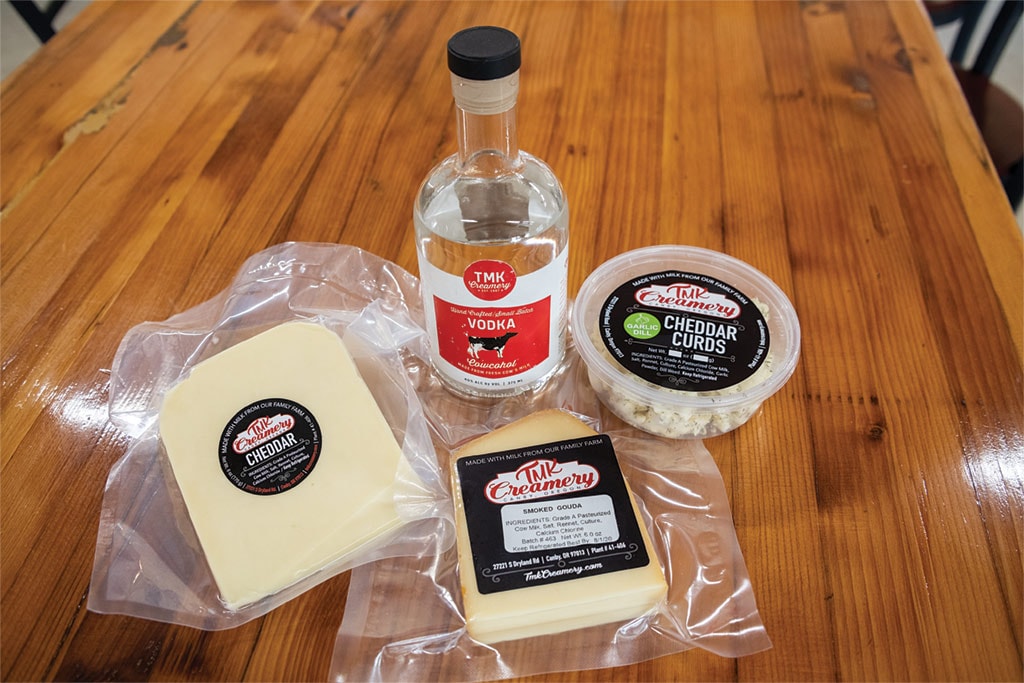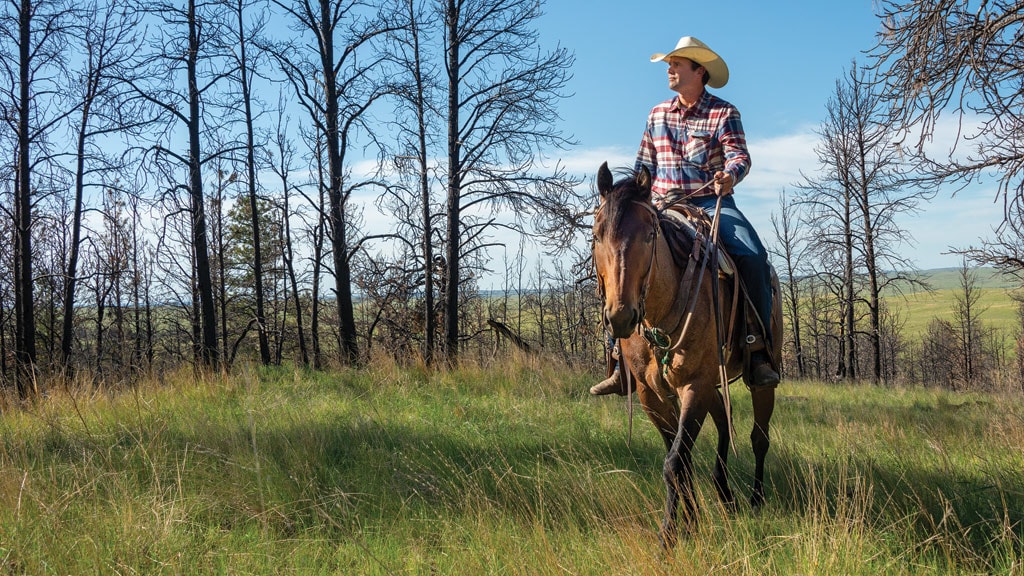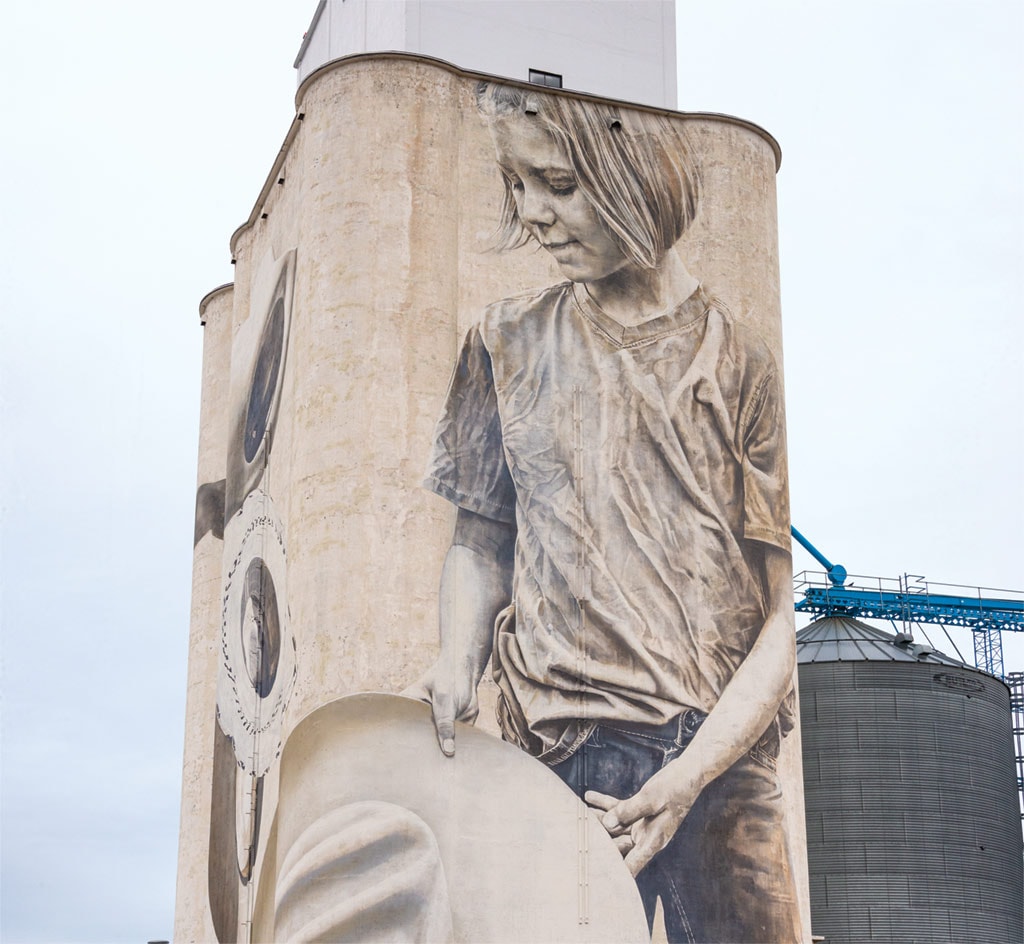
Agriculture January 01, 2021
Rural Murals
Communities tell their stories on grain bins and buildings.
Street art has gone country! From the facades of high end restaurants and boutiques in New York’s fashionable SoHo district, the plus-sized public art form is migrating to such rustic places as the side of the Agtegra Coop grain elevator in Faulkton, South Dakota or to a concrete wall on the south side of Shorty’s barber shop in Waukomis, Oklahoma. The trend is not only transforming rural infrastructure into sites of world class mural art, it’s also telling stories of people and places that serve to rekindle lagging pride while also spurring local business.
The 110-foot tall mural on Faulkton’s grain elevator (shown above) is a great example. “Some people thought we were crazy and wondered why would anybody want to put art on the grain elevator,” says Jodi Moritz, member of the Faulkton Area Arts Council. “Now, the elevator and the other murals in town are a source of pride, and the expected boost in tourism has proven to be true. That means an uptick in customers for local businesses.
The mural was painted by award winning Australian artist Guido Van Helten, who’s done several similar grain silo murals along Australia’s Silo Art Trail (read more later). Van Helten spent more than a month with farmers, ranchers and townspeople in Faulk County to get a feel for the community and formulate a design for the mural.
“I wanted my mural to reflect the spirit of the people in this community and portray what daily life is like in rural South Dakota,” says Van Helten. “I was impressed with people’s commitment to the land, to their family and to their community. The iconic images I chose were a young boy and girl in big hats, blue jeans and dirty shirts.”
Van Helten adds that he’s obsessed with bringing small details to a very large scale. “I want the mural to be a monument to this place and I want people to go out of their way to experience it,” he says.
“The mural has had a big impact on business because people now stop rather than just driving through town, but what it’s done for community pride and morale is even greater,” says Dave Hedt, a former Australian resident who knew of Van Helten and arranged for him to come to South Dakota.
“Guido did a huge mural on the grain silo in my former hometown of Brim, Victoria,” says Hedt. “Brim is 225 miles from Melbourne and has a population of only 170 people, but many days there are 1,000 people who come to look at that mural.”
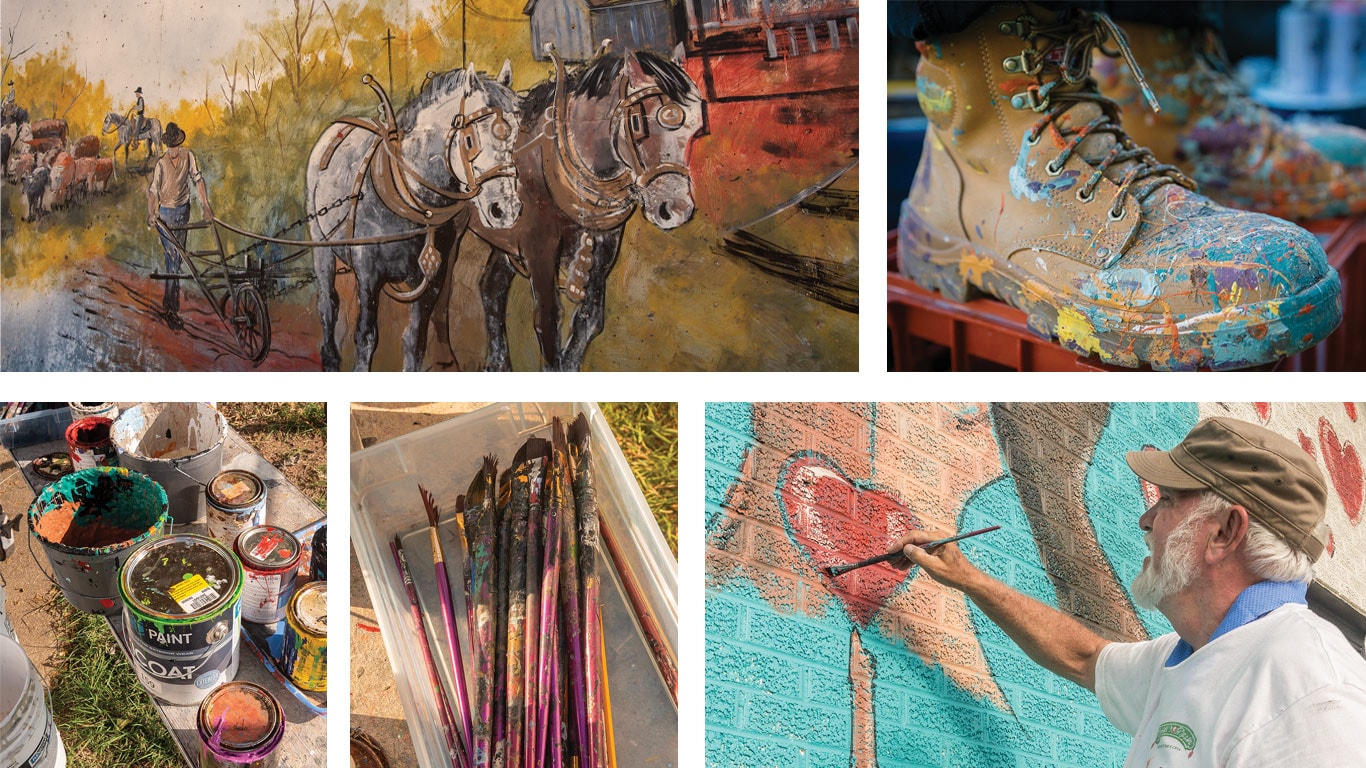
The Pioneer Memorial Mural in Waukomis, Oklahoma, depicts seven different features of regional history.
Small town pride. Faulkton’s elevator was painted over the summer of 2018. The total cost—including equipment rental—was roughly $100,000.
“It was quite an event,” says Hedt. “Every day people would park their car with chairs and picnic supplies and come watch Guido maneuver around while painting from a boom lift. He even had a painting class for our school children.”
Van Helten had previously done super-sized murals in Florida and Tennessee and has since done grain elevators in Fort Dodge, Iowa and Mankato, Minnesota. He’s also applied his monochromatic style to large murals in a host of other countries.
It’s nearly impossible to drive across Oklahoma and not see Bob Palmer’s murals. He’s painted more than 3,500 and most grace the walls of buildings and water towers in small towns in the state. Nearly 500 of his murals are featured in his new book Painting Oklahoma and Beyond (palmerstudiosinc@ gmail.com).
“I’ve done many major projects in large cities, but small town murals are my favorite,” says Palmer, a retired university art instructor whose crew typically includes three to five former students. “I enjoy getting into the history of the community and the people. They take a special pride in the final product so it’s very rewarding.”
The north central Oklahoma town of Waukomis has a population of 1,250 people and sports two of Palmer’s murals. Downtown, the Pioneer Memorial Mural portrays seven facets of the town’s history. Its location along the Chisholm Trail is depicted by a drover herding several cattle. The 1893 Cherokee Strip Land Run that occurred in the area is represented by a wagon driver dashing to stake his claim. The town’s first school and church are included, as well as a steam locomotive from the town’s early railroad days.
Early pioneers were wheat farmers and are shown plowing behind a two-horse hitch. A bucking horse and rider depict well known trick rider Cecil Cornish and the very tall figure on the far end of the mural represents the resident who—at a height of 8 feet 2 inches—was tabbed as the tallest man in the world in 1900.
“When you paint small town murals you quickly learn to do your homework or somebody is sure to point out an error. I once painted an unloading auger on the wrong side of a combine and within 20 minutes five pickup trucks had stopped so farmers could point out the error,” says Palmer.
Waukomis’s second Palmer artwork is on a long warehouse wall of the Land Run Farmer’s Coop. It also focuses on the town’s railroad history, wheat farming legacy and the area’s historic cattle drives.
“We use the highest quality exterior paint and, depending on the exposure, it can last 30 years. Red fades the quickest and we do a lot of patriotic- themed murals, so we’ve had the paint company develop a higher quality red paint,” says Palmer.
Post Office murals. Murals were the focus of a New Deal era effort by the Roosevelt administration to boost the morale of rural Americans during the Great Depression. The program commissioned artists to paint murals in the post office of communities judged to be hardest hit by the financial stress of the time. Murals were typically 12’ by 5’ and installed over the doorway to the postmaster’s office.
A total of 1,371 murals were painted by 850 artists who typically were paid $700 for their work. Many of those murals can still be seen today, including the one in the post office in Russell, Kansas.
“We get a lot of visitors who are aware of the mural project and make it a point to stop when in this area,” says postmaster Troy Rathbun. “Locals are especially proud because ours shows wheat farming and oil production—major factors in the local heritage.”
Interest in the remaining post office murals has peaked in recent years. A list of their locations is available at livingnewdeal.org.
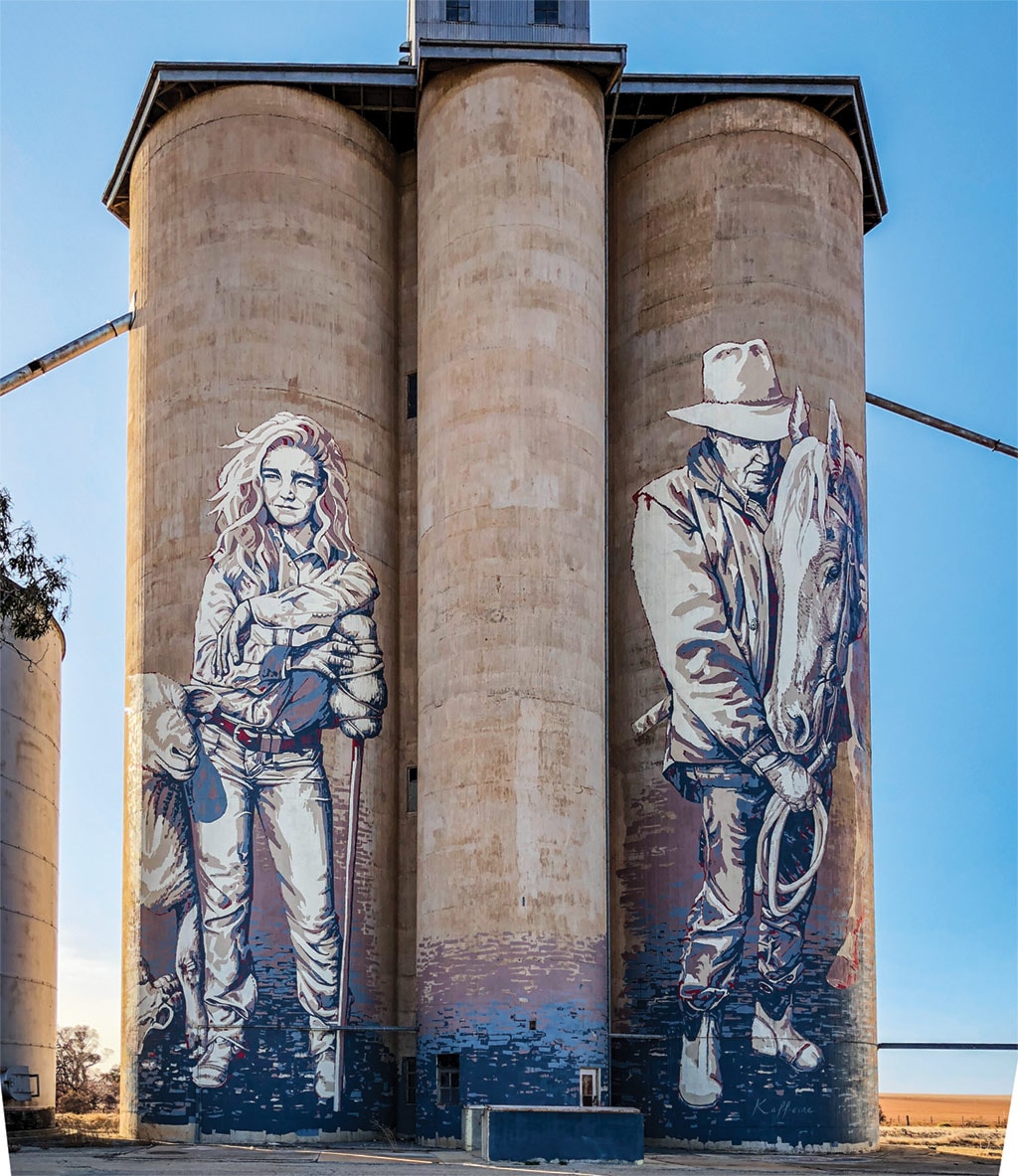
Silo art in Rosebery, Victoria, celebrates ranching heritage (photo by Annette Green).
Rural salvation. Giant murals painted on grain silos and water towers are helping save struggling rural communities in Australia. The five year old effort has recently been organized into the Australian Silo Art Trail, (australiansiloart. com) a driving tour that spans 4,700 miles, includes 35 towns and—prior to pandemic travel restrictions—was luring travelers by the thousands.
“It’s the biggest outdoor art gallery in the world,” says Annette Green, who organized the trail and launched online marketing efforts soon after her and husband Eric discovered their first silo mural in 2018.
“The sheer size of the artwork blew us away, but we soon realized that there was more to this than just the silo art. It was also about the communities and the people who lived within them who were struggling through one of the greatest droughts Australia had ever seen. We wanted to share the plight of those communities and promote regional tourism that could boost their local businesses,” adds Green.
The first silo was painted in March 2015 in the wheatbelt town of Northam, Western Australia. The effort was sparked by cooperation between FORM—a local cultural organization—and elevator owner GBH Group.
Two muralists worked on four silos on opposite ends of the 16-silo complex while up to 70
trucks a day still utilized the facility. The artist at one end chose to celebrate the area’s rich aviation history (left) while the other painted a more modernistic ‘explosion of color.’
“Little did they know that the concept of painting silos would infuse a nation with newfound energy and enthusiasm,” says Green. “Before long there was a second painted silo in Brim, Victoria (by Guido Van Helten).”
Three more silo murals were added in 2016, nine more in 2017. eleven more in 2018 and ten more in 2019 for a current total of 35. “As many as 25 more towns are also somewhere in the planning mode,” says Green.
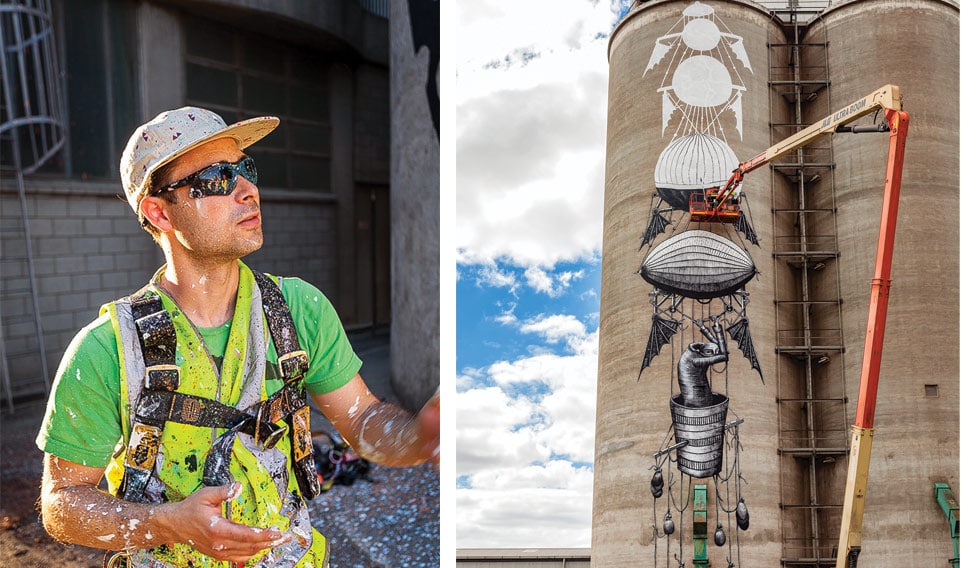
A mural on one end of an elevator in Northam, Western Australia, uses Leonardo da Vinci’s style to depict the area’s aviation history
It all appears to be paying off. In South Australia, Tumbly Bay’s silo was painted in 2018 and occupancy in their RV park promptly doubled and a new French Cafe opened. And in Coonalpyn, three new businesses opened, including one that’s aptly named Silo Cafe.
Stories to tell. These silo murals are spread across five states, some of which have their own marketing efforts that collectively make the Australian Silo Art Trail.
The first of these is FORM’s PUBLIC Silo Trail in Western Australia. “The murals have been a game changer for bringing renewed emphasis and positive perceptions to the region, people and industries,” says Kim Kirkman FORM staff writer.
The trail’s marketing efforts also include Stories From the Silo Towns—a video and publication that captures and preserves not only the character of Western Australia’s farming communities, but also a sense of the epic scale and remoteness that characterizes the region. Find it at publicsilotrail. com. ‡
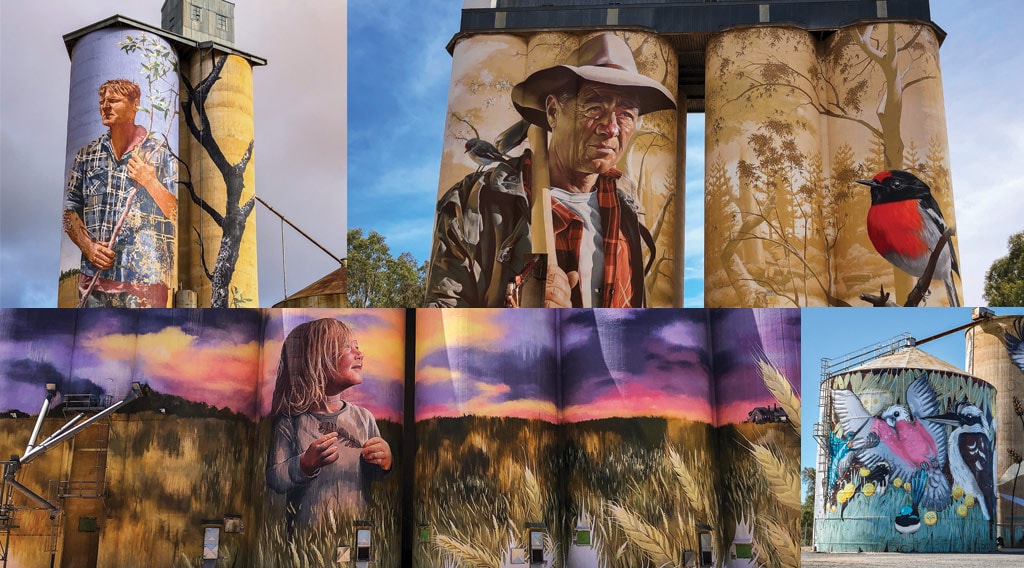
Painted grain silos in Pachewollock, Victoria (top left) Wirrabara, South Australia (top right) Kimba, South Australia (lower left) and Tungamah, Victoria (lower right) 35 Murals on Silo Art Trail

